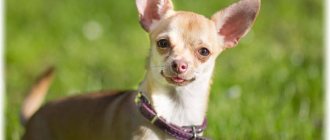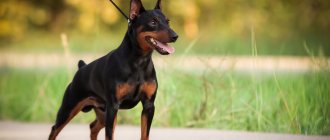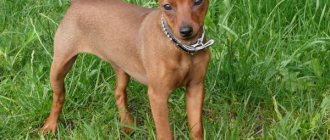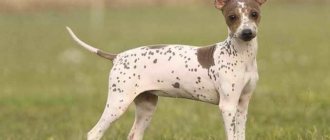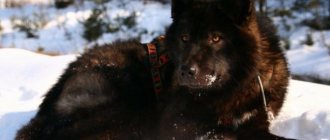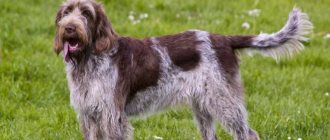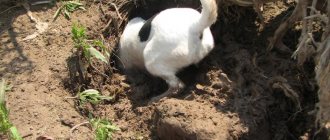The Samoyed Laika or Samoyed is a snow-white, fluffy dog whose homeland is the north. She has natural beauty and a friendly personality.
The dog has light thick fur, black eyes and a proportional build.
Since ancient times, Samoyeds have helped people survive in the harsh conditions of the server. At the same time, they were distinguished by intelligence, endurance and obedience.
Now he is a family dog, an excellent watchman and companion.
In this article we will talk about why Samoyeds are called that, what features they have and who such pets are suitable for.
origin of name
There are several versions of why this breed is called that.
Some experts believe that the origin of the name comes from the server people living in Russia. In ancient times, the name sounded exactly like that - Samoyeds. The modern name of the nationality is Nenets.
To be more precise, this nation was named from the ancient word “samoyad”, which means “self-contained”, “closed in itself”. This can be understood as the closed way of life of an ethnic group and its closedness from other people.
Another version says that the name comes from the words “sam” and “to go,” since residents of the north often traveled on skis.
There are also versions that the dogs were called Samoyeds because of their color. After all, when they were transporting the team, they were almost invisible in the snow and it seemed that the team was driving itself.
Another option where the name of the breed came from is the expression “saam-jedna”, which means “land inhabited by the Sami”.
NOTE!
The Sami are a small ethnic group of northern peoples living in Norway, Finland and Russia.
Mating
It is recommended to breed bitches no earlier than 18 months. When breeding, you should take care to obtain a certificate about the condition of the hip joints. Dogs can be mated between 11 and 14 days from the moment the bitch begins bleeding.
Mating is best done in the male dog's territory. To do this, you will need to pay for the services of an instructor, since due to the increased activity of representatives of the breed, the courtship process is too delayed, against which the moment for mating may be missed.
History of appearance
It is believed that the ancestors of the current Samoyeds were brought to Europe by the Englishman Joseph Wiggens during the establishment of trade relations with Siberia. But this fact has no documentary evidence.
The North of Russia is considered the homeland of Samoyeds, and the history of the breed goes back centuries. For many years, the Nenets used this breed as household helpers. Dogs served as guards, “workhorses”, and were used in hunting.
They were also wonderful nannies. On cold server nights, the dogs warmed the babies with their bodies. For many years they did not leave their homeland. And only in 1889, the Englishman Ernst K. Scott took several individuals to England, after which a nursery was organized.
This is how the breed was saved from extinction. Over time, thanks to its qualities, the breed began to gain popularity in Europe.
It is known that there were several Samoyed huskies at the court of King Edward VII. And in 1920, the English Samoyed Association was organized, where breed standards were approved. Later the breed was recognized by other European countries.
At this time, in their historical homeland, Samoyeds were undeservedly forgotten and almost disappeared. Only in 1989 were dogs brought to the USSR from Denmark.
Nowadays Samoyeds can be found all over the world.
The Samoyed husky in its modern form has not lost its hunting qualities and has a pursuit instinct. Such a dog can hunt mice, birds, lizards or other small animals.
Where to buy a puppy
Nurseries in Ukraine:
- “Treasures of the Valkyrie” Kyiv – https://samoyed.kiev.ua
- “Samville Samoyeds” Drohobych – https://samvillesamoyeds.com
Nurseries in Russia:
- “Joy of Life” Moscow – https://serenadasamoed.ru
- “Serenade of the Northern Valley” St. Petersburg – https://serenadasamoed.ru
If you want to buy not just a dog, but a real friend who is not capable of harming a child, then the Samoyed Laika will not disappoint. This good-natured dog requires care, but in return will give love, devotion and cheerfulness.
Interesting Facts
Interesting Facts:
- Some Samoyed owners notice their habit of rolling on slippery paths when walking. And when climbing a mountain, the dog runs ahead and helps the owner get up.
- Such dogs are often kept in hospitals for the mentally ill. Here they help patients cope with mental illness.
- Representatives of the Samoyed breed really do not like to swim. Apparently, origin plays a role. In the homeland of these dogs, water is called wormwood, which translated means death.
- The pet completely lacks the characteristic dog smell.
- In the north, Samoyeds are used as hunters of walruses, deer and bears.
- According to one version, the ancestor of the Samoyed is a cross between a polar wolf and an arctic fox.
Samoyed dog - a snow-white miracle
One of the oldest breeds that has survived to this day is the Samoyed dog. This is a combination of charm, grace and developed intelligence. Samoyeds attract with their snow-white fur coat and positive smile. We hope our article will be useful not only to those who are already the happy owner of this breed, but also to those who are planning to get themselves a four-legged friend.
Photo and description
The Samoyed is a medium-sized , strong, muscular and slender. This pet is distinguished by its extraordinary beauty, because the Samoyed is a white, fluffy dog with dark eyes and thick hair.
The dog has a conical muzzle, and the skull is wide and slightly convex.
The nose is black, as are the lips. The bite is scissor-shaped.
Particular attention should be paid to the “facial expression” of the dog, since the whole range of emotions can be reflected on its face. This is where the expression came from - the Samoyed smile.
The eye shape is almond-shaped. The pet's eyes are black, deep-set and slightly slanted. Any eye color other than black is considered a breeding defect.
The dog has small erect ears, triangular in shape, slightly rounded at the tips.
The body of the Samoyed is much longer than the height at the withers, but the dog is proportionally and harmoniously built.
The neck is of medium length, quite powerful, curved.
The tail is set high and carried over the back. In a state of calm, the dog can lower it.
The pet's coat is thick, long and very dense, with a thick undercoat. The neck and shoulders are decorated with a fluffy collar, and beautiful “pants” are on the hips.
Color - from snow-white to cream.
IMPORTANT!
If the Samoyed's color contains pale brown or light coffee tones, this indicates that the breed is not pure enough.
Varieties
The difference in appearance allows all Samoyeds to be divided into two large groups.
Group 1. “Bear type” or “Cattle dogs”.
This type is endowed with a powerful, massive, strong physique. Short legs and short back. Wide skull, weighty skeleton. This type includes the following breeds: English, Australian, New Zealand, South African, FCI.
Group 2. “Wolf type” or “Sled dogs”.
Characterized by a narrow skull, elongated legs, and torso. Smaller chest size, short coat. These include: American and Canadian breeds.
The most famous dogs in history: nicknames, breeds, photos
There is another category of dog characteristics that determines the division into varieties, this is color.
The white color is considered popular, loved on different continents. Such Samoyeds do not overheat in hot weather, despite their thick undercoat. Ultraviolet light is reflected from the dazzling white color. At certain points in a dog’s life, the coat may acquire a yellowish tint. This is affected by pregnancy, excess protein, parasites, and diseases of the gastrointestinal tract.
Character traits
Samoyeds are kind and obedient dogs, always ready to play and have fun. They are always full of life and enthusiasm, friends of children and other pets. Sometimes they are too trusting and friendly, which negatively affects their qualities as guards.
Such pets enjoy spending time with their owner and members of the family. No matter what they do, the dog will always be there.
If you don't give your dog enough attention, he starts to get bored and anxious. Such pets are very susceptible to separation anxiety from their owner, so inattention to them can lead to behavioral disorders. A pet left for a long time may bark, howl, chew things, or shit in inappropriate places for no reason.
Samoyeds are very smart, independent and stubborn, which means they need a firm and principled owner. In addition, they get along well with children and other animals.
As for Samoyed puppies , they can be too active, talkative and annoying. Such traits in a pet remain for approximately 2 years.
Dogs are perfectly adapted to live outdoors and can easily be kept in the yard. They are independent, calm and affectionate, and proper training makes them ideal companions.
It is also worth saying that Samoyeds are quite proud, they love to be the center of attention and willingly participate in any family activities. In addition, they are characterized by curiosity and mischief.
Is it worth getting a Samoyed?
The answer to this question lies in the lifestyle and wishes of the owner.
- Definitely not suitable for inactive people - this breed requires long walks with active games.
- Will not guard a house or apartment - the breed does not have the aggressiveness necessary to perform guard functions.
- It often barks and howls - you should refrain from getting such a dog if you have very young children: loud sounds can scare a child.
- Busy people with busy schedules and business trips are not recommended to get a Samoyed - the dog does not tolerate long-term loneliness and lack of communication with the owner.
- Those who love cleanliness and order will find it difficult to come to terms with seasonal shedding: there will be a lot of wool.
But for those who need a four-legged friend who radiates friendliness, loves the whole family, adores children and does not offend other animals, the Samoyed will be an excellent choice.
Advantages and disadvantages
Pros:
- Friendly character and love for children. This breed is very patient and affectionate with children. The Samoyed can endlessly tolerate the whims and pranks of kids.
- Lack of aggression. The Samoyed is a dog for the whole family - a wonderful companion, friend and nanny. Moreover, the dog is friendly not only with members of the seven, but also with strangers.
- Devotion to the owner. The Samoyed is very attached to its owner and family members.
- Highly intelligent, the dog is highly trainable and happily follows commands.
- Cheerful and positive disposition. The Samoyed enjoys participating in all family events, entertainment and everyday activities.
- Easy to care for. The dog requires almost no bathing or nail trimming. In addition, Samoyeds have good health and rarely get sick.
- Calm attitude towards other pets. Samoyeds get along well with cats and other dogs.
Minuses:
- Tendency to shed. The reason is fluffy and thick wool.
- The need for physical activity. The breed is not suitable for elderly and lazy people.
- The dog does not tolerate heat well, since the Samoyed’s homeland is the tundra.
- If raised incorrectly, the pet becomes wayward and disobedient.
- There is a tendency to steal. A poorly behaved Samoyed may steal or beg for food.
- High price for puppies.
- Tendency to bark and howl. If a dog is bored or yearns for its owner, then barking and howling will be its usual activities.
Tendency to train
Raising and training Samoyeds is a specific activity, during which it is necessary to take into account that these dogs are pack dogs.
The first thing to start training a puppy with is the hierarchy in the pack.
Once in a family, a Samoyed baby immediately begins to figure out his own role in it. The owner’s task is to define his own leadership and establish rules of behavior. It should not be allowed that some people praise the dog for the same act, while others scold it. The rules must be the same for everyone.
You can teach your puppy simple commands on your own, armed with patience and perseverance. And it is better to delegate more complex tasks to a professional - he will study the temperament and character of the dog, take into account breed inclinations and build a training process.
You cannot shout or hit the dog. The Samoyed reacts very sharply to injustice. But, of course, it is necessary to punish for wrongdoing. To do this, you need to take the dog by the scruff of the neck, lift it, and then press its muzzle to the floor. The Samoyed will not be hurt, but he will understand that he did something wrong.
How to properly care?
The Samoyed requires special care. The reason for this is the thick and lush fur. The dog is prone to shedding, so it should be brushed at least once a week. In addition, fluffy fur should be brushed.
It is recommended to bathe your dog no more than 2-3 times a year. After all, Samoyeds are very clean and do not have a specific dog smell.
As for the claws, there is no need to cut them; they grind down on their own.
At the same time, the Samoyed Laika's teeth require careful care. Brush your pet's teeth 2-3 times a week using meat-flavored toothpaste and a dog toothbrush.
Clean your pet's ears once a month using a cotton swab dipped in a special lotion. In this case, the tampon should be damp, not wet, so that drops of liquid do not get into the ear, otherwise it can cause inflammation of the ear canal.
Another important point is walking. Be sure to walk your dog every day. Samoyeds especially love cold and snowy weather.
NOTE!
The dog really doesn’t like to bathe, it’s really stressful for him.
Samoyed Laika is a hypoallergenic dog
There is a widespread belief that representatives of this breed are hypoallergenic animals. This is explained by the complete absence of “dog” smell from the fur. However, such information is not completely correct. Allergies are simply not caused by a specific individual in any person. Therefore, before purchasing a puppy, be sure to get tested for allergens.
Life expectancy and diseases
The average lifespan of a Samoyed is 12–13 years.
Main diseases:
- Cataract.
- Hip dysplasia.
- Diabetes.
- Pigmentation of the nasal lobe.
- Retinal atrophy.
- Deafness.
Owner reviews
Olga: “The Samoyed is so good-natured and loves children that it’s not scary to leave a baby with him who has just started walking. The dog will play with the child and will not harm him even by accident.”
Alexey: “Dogs are cunning and smart. Pets are able to get out of any enclosure and love to walk on their own, which is something to be wary of. Long off-leash walks can help prevent escapes.”
Oksana: “There is simply no breed smarter than Samoyed Laikas. The dog is easy to train and suitable for show programs. And her charming appearance with a “Samoyed smile” will not leave any viewer indifferent.”
What's best to feed?
Most veterinarians recommend feeding the Samoyed dry food, as it contains the right amount of nutrients.
But natural nutrition is also acceptable. First of all, it should be said that the Samoyed must be given raw meat. This is the basis of the diet. The second important point is milk; it should be completely excluded from the diet, as it causes diarrhea in the dog.
IMPORTANT!
Do not teach your dog to feed from your hands or from the floor. She must have her own bowl and a certain time for feeding.
Diet of an adult Samoyed:
- 30% – meat (raw or cooked),
- 30% - fermented milk products (yogurt, kefir, cottage cheese),
- 20% - boiled sea fish (dogs love it very much),
- 20% - cereals, vegetables, offal (beef tripe, heart, liver).
Prohibited products:
- Chocolate.
- Eggs.
- Smoked meats.
- Potatoes and beans.
- Pork.
- Baking.
You need to feed your pet strictly 2 times a day.
You can use cheese, sugar seeds or rye crackers as a treat.
It is better to feed your pet after a walk. This promotes better absorption of food and also prevents excess weight.
Learning ability
Samoyeds were not bred to serve humans, as a guard or service dog. Their purpose was completely different. Therefore, there is no need to require them to strictly follow commands. If this is your first time encountering the breed, then the best solution would be to contact a professional dog handler.
Of course, you won’t get ideal behavior like a German Shepherd, but it’s quite possible to teach basic commands. From the first days of life in a new home, the puppy must be explained the rules of behavior and the limits of what is permitted.
Until full vaccination, you should exercise at home. Initially, you will have to start teaching the animal the name. To do this, you need to call him by name as often as possible. Then he will begin to get used to the leash and collar. They must first be put on for a short time, because... Equipment can be a source of stress for a puppy.
It is important to teach the dog the prohibitive command “no” or “fu”. This will help you avoid eating edible and inedible items outside the home. The command is especially relevant during a walk, when the puppy happily runs after a lying bone.
It is necessary to know the basic commands from the general training course: sit, lie down, stand, towards me, next to me and place.
To have fun with your pet, you can start learning tricks.
Showing teeth and stance is related to show dogs.
